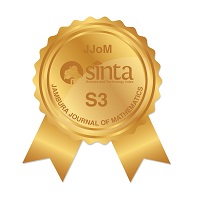Self-Organizing Map Menggunakan Davies-Bouldin Index dalam Pengelompokan Wilayah Indonesia Berdasarkan Konsumsi Pangan
Abstract
ABSTRAK
Kecukupan konsumsi pangan merupakan salah satu penunjang terbentuknya sumber daya manusia unggul yang menjadi fokus kebijakan pembangunan di Indonesia. Agar konsumsi pangan terpenuhi, salah satu cara yang dapat dilakukan adalah melakukan pengelompokan wilayah berdasarkan konsumsi pangan. Penelitian ini bertujuan untuk mengelompokkan wilayah Indonesia berdasarkan konsumsi pangan berdasarkan data konsumsi kalori per kapita sehari dari berbagai komoditas pangan. Pengelompokan wilayah dilakukan dengan metode self-organizing map (SOM) dengan terlebih dahulu ditentukan jumlah cluster optimum menggunakan nilai Davies-Bouldin Index (DBI) terkecil. Hasil penelitian menunjukkan bahwa hasil cluster optimum yang terbentuk sejumlah 4 cluster dengan jumlah anggota untuk cluster 1 sebanyak 22 provinsi, cluster 2 sebanyak 10 provinsi, cluster 3 sebanyak 1 provinsi, dan cluster 4 sebanyak 1 provinsi.
ABSTRACT
Adequate food consumption is one of the supports for forming superior human resources, which is the focus of development policies in Indonesia. To fulfill food consumption, one way to be done is to group regions based on food consumption. This study aims to classify regions of Indonesia based on food consumption based on average daily per capita calorie consumption data from various food commodities. Regional grouping is done using the self-organizing map (SOM) method by first determining the optimum number of clusters using the smallest Davies-Bouldin Index (DBI) value. The results showed that the optimum cluster results were 4 clusters with the number of members for cluster 1 as many as 22 provinces, cluster 2 as many as 10 provinces, cluster 3 as many as 1 province, and cluster 4 as many as 1 province.
Keywords
Full Text:
PDF [INDONESIA]References
Kemenkeu, "3 Fokus Kebijakan Pembangunan Pembangunan Indonesia di Masa Mendatang" Publikasi Kementerian Keuangan Republik Indonesia, Jakarta, 2020.
K. von Grebmer et al., 2020 Global hunger index: One decade to zero hunger, linking health and sustainable food systems. Dublin: Welthungerhilfe & Concern Worldwide, 2020.
Kemenpan, Kebijakan Strategis Ketahanan Pangan dan Gizi 2020-2024. Jakarta: Badan Ketahanan Pangan Kementerian Pertanian, 2019.
J. Han, M. Kamber, and J. Pei, Data Mining Consepts and Techniques Third Edition. United States of America: ELSEVIER, 2012.
R. Xu and D. C. Wunsch, Clustering. New Jersey: John Wiley & Sons, Inc., 2009.
L. Yang, Z. Ouyang, and Y. Shi, "A modified clustering method based on self-organizing maps and its applications" Procedia Comput. Sci., vol. 9, pp. 1371-1379, 2012, doi: 10.1016/j.procs.2012.04.151.
T. Kohonen, "The Self-Organizing Map" Proc. IEEE, vol. 78, no. 9, pp. 1464-1480, 1990, doi: 10.1109/5.58325.
Y. Li et al., "Land use pattern, irrigation, and fertilization effects of rice-wheat rotation on water quality of ponds by using self-organizing map in agricultural watersheds" Agric. Ecosyst. Environ., vol. 272, no. November 2018, pp. 155-164, 2019, doi: 10.1016/j.agee.2018.11.021.
V. J. A. S. Lobo, "Application of self-organizing maps to the maritime environment" Lect. Notes Geoinf. Cartogr., no. June, pp. 19-36, 2009, doi: 10.1007/978-3-642-00304-2_2.
P. PotoÄnik et al., "SOM-Based Clustering and Optimization of Production" 2017.
P. Juntunen, M. Liukkonen, M. Lehtola, and Y. Hiltunen, "Cluster analysis by self-organizing maps: An application to the modelling of water quality in a treatment process" Appl. Soft Comput. J., vol. 13, no. 7, pp. 3191-3196, 2013, doi: 10.1016/j.asoc.2013.01.027.
P. Zeng, F. Sun, Y. Liu, Y. Wang, G. Li, and Y. Che, "Mapping future droughts under global warming across China: A combined multi-timescale meteorological drought index and SOM-Kmeans approach" Weather Clim. Extrem., vol. 31, p. 100304, 2021, doi: 10.1016/j.wace.2021.100304.
P. Melin, J. C. Monica, D. Sanchez, and O. Castillo, "Analysis of Spatial Spread Relationships of Coronavirus (COVID-19) Pandemic in the World using Self Organizing Maps" Chaos, Solitons and Fractals, vol. 138, p. 109917, 2020, doi: 10.1016/j.chaos.2020.109917.
S. M. Guthikonda, Kohonen Self-Organizing Maps. Wittenberg University, 2005.
D. L. Davies and D. W. Bouldin, "A Cluster Separation Measure" IEEE Trans. Pattern Anal. Mach. Intell., vol. 1, no. 2A, 1979, doi: https://doi.org/10.1109/TPAMI.1979.4766909.
T. Kohonen, "Self-Organized Formation of Topologically Correct Feature Maps" Biol. Cybern., vol. 43, pp. 59-69, 1982.
U. Asan and E. Secil, "An Introduction to Self-Organizing Maps" Atlantis Press Book, 2012.
D. T. Larose and C. D. Larose, Discovering Knowledge in Data: An Introduction to Data Mining Second Edition. United States of America: John Wiley & Sons, Inc, 2014.
BPS, Konsumsi Kalori dan Protein Penduduk Indonesia dan Provinsi Berdasarkan Hasil Susenas Maret 2020. Jakarta: Badan Pusat Statistik, 2020.
DOI: https://doi.org/10.34312/jjom.v3i2.10942
Copyright (c) 2021 Mujiati Dwi Kartikasari

This work is licensed under a Creative Commons Attribution-NonCommercial 4.0 International License.
Jambura Journal of Mathematics has been indexed by
Jambura Journal of Mathematics (e-ISSN: 2656-1344) by Department of Mathematics Universitas Negeri Gorontalo is licensed under a Creative Commons Attribution-NonCommercial 4.0 International License. Powered by Public Knowledge Project OJS.
Editorial Office
Department of Mathematics, Faculty of Mathematics and Natural Science, Universitas Negeri Gorontalo
Jl. Prof. Dr. Ing. B. J. Habibie, Moutong, Tilongkabila, Kabupaten Bone Bolango, Gorontalo, Indonesia
Email: [email protected].



















